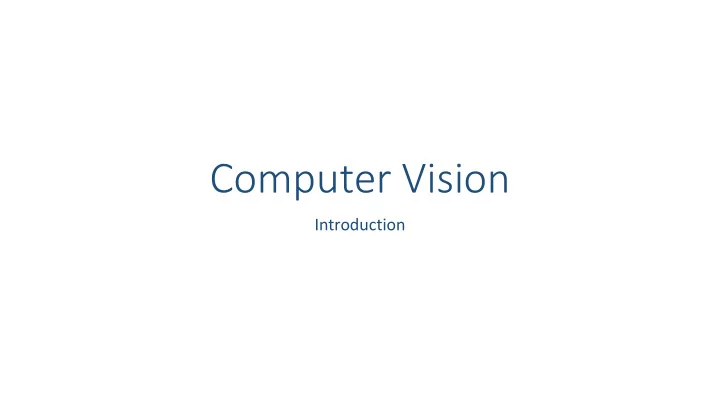

Computer Vision Introduction
Historical context
Connections to other disciplines
Vision and Graphics
Dual aspect of vision: analysis and synthesis
Applications of computer vision
Applications of computer vision
Historical context
Machine vision phylogenesis
The human eye anatomy and visual field
The retina structure
The functional field of view
Human percetion
Human percetion
Optical illusions
Electromagnetic spectrum
Electromagnetic spectrum
Electromagnetic spectrum
Electromagnetic spectrum
Electromagnetic spectrum
Electromagnetic spectrum
Ultrasound imaging
Spatial resolution • The spatial resolution is related to the dimention of the details that can be detected • The resolution cell is the smallest area with an associated value in a digital image • The cell is usually a square (but sametimes other shapes are used) • The pixel corresponds to the elementary cell
Spatial resolution
Color depth • The color depth is the number of bits of each pixel • A binary image is an image where each pixel can have only two values: (0, 1), (false, true), (object, background) • A binary image uses only a bit for each pixel • A gray image is an image that uses larger ranges • Some common values: [0,63], [0,255], [0,1023] (6, 8, 10 bit) • A human being can deal with 8 bits
Gray scale resolution
Color images • The color images usually memorize 3 values for each pixel (red channel, green channel, blue channel) • Each pixel usually use 1 byte (8 bits) so we can have 256x256x256 different colors (~4 millions) • A human being is not able to discriminate so much colors
Color images • Color image • Red channel • Green channel • Blue channel
Color models • There are many modes to deal with colors • They are related to the final task • RGB - monitors • CMYK – cyan, magenta, yellow, black - printers
Set of usable colors • The colors of a monitor are not the same of printable colors
Color models • YIQ – luminance, inphase, quadrature – tv color • HIS – hue, saturation, intensity • HSV – hue, saturation, value • HSB – hue, saturation, brightness
HSV • 0°: 255, 0, 0 • 60°: 255, 255, 0 • 120°: 0, 255, 0 • 180°: 0, 255, 255 • 240°: 0, 0, 255 • 300°: 255, 0, 255
Color images • A possible choice to limit the memory use a reduced number of colors is used (8, 4, 1 bits each pixel) • So also a color LUT (look up table) is memorized
Color images • Original image • 256 colors • 16 colors • 8 colors
Color lut red green blue Pixel value R1 G1 B1 R2 G2 B2 Visualize value (R4, G4, B4) R3 G3 B3 R4 G4 B4 R5 G5 B5 R6 G6 B6
BMP images typedef struct { File structure short magic; /* "BM" */ long file_dim; /* file dimension */ long l0; /* 0 */ long header_dim; /* header dimension */ Header long l40; /* 40 */ long xsize; /* image width */ LUT long ysize; /* image height */ short nchan; /* 1 */ Pixel values short zsize; /* 1-4-8-24-32 */ long compression; /* 0 -> no compression */ long data_dim; /* data dimension */ long xppi; long yppi; long colors; /* lut dimension */ long colors1; } bmp_header;
PGM (portable gray map) images File structure: An ASCII Header (humen readable): «P5» (magic number) width height Maximum pixel value (usually 255) An arbitrary number of comments lines may be present (beginning with ‘#’) Image data: 1 byte each pixel
PGM (ascii) images File structure: An ASCII Header (humen readable): «P2» (magic number) width height Maximum pixel value (usually 255) An arbitrary number of comments lines may be present (beginning with ‘#’) Image data: 1 human readable number each pixel
PPM (portable pixel map) images File structure: An ASCII Header (humen readable): «P6» (magic number) width height Maximum pixel value (usually 255) An arbitrary number of comments lines may be present (beginning with ‘#’) Image data: 3 bytes for each pixel (RGB)
PPM (ascii) images File structure: An ASCII Header (humen readable): «P3» (magic number) width height Maximum pixel value (usually 255) An arbitrary number of comments lines may be present (beginning with ‘#’) Image data: 3 human readable numbers each pixel
GIF images File structure: «GIF89a» (magic number) A Header (width, height, number of colors): Color lut Compressed image data
GIF images • PPM image 290 Kb • GIF image 53 Kb • Lossless compression: it is possible to reconstruct the original image data (if the number of colors is at most 256)
JPG images • The image is subdivided in blocks of 16x16 pixels • An analysis in the frequence domain is done and high frequence componentsare eliminated (humans do not well recognize) • For visualization the result is good
JPG images • PPM image 290 Kb • JPG image 25 Kb • Lossy compression: it is not possible to reconstruct the original image data • The compression level is a parameter of the transformation process magick rose: – quality 80% rose.jpg
ARGB images • Sometimes pixel values are memorize as integer values of 32 bits • In this case it is used a fourth channel (alpha channel). It is used to memorize the degree of visibility of the pixel: 0 value corresponds to a transparent pixel, 255 to a opaque pixel • Alpha channel can be used in Java images, in PNG images and in BMP imgages (obviously they are only examples).
Recommend
More recommend